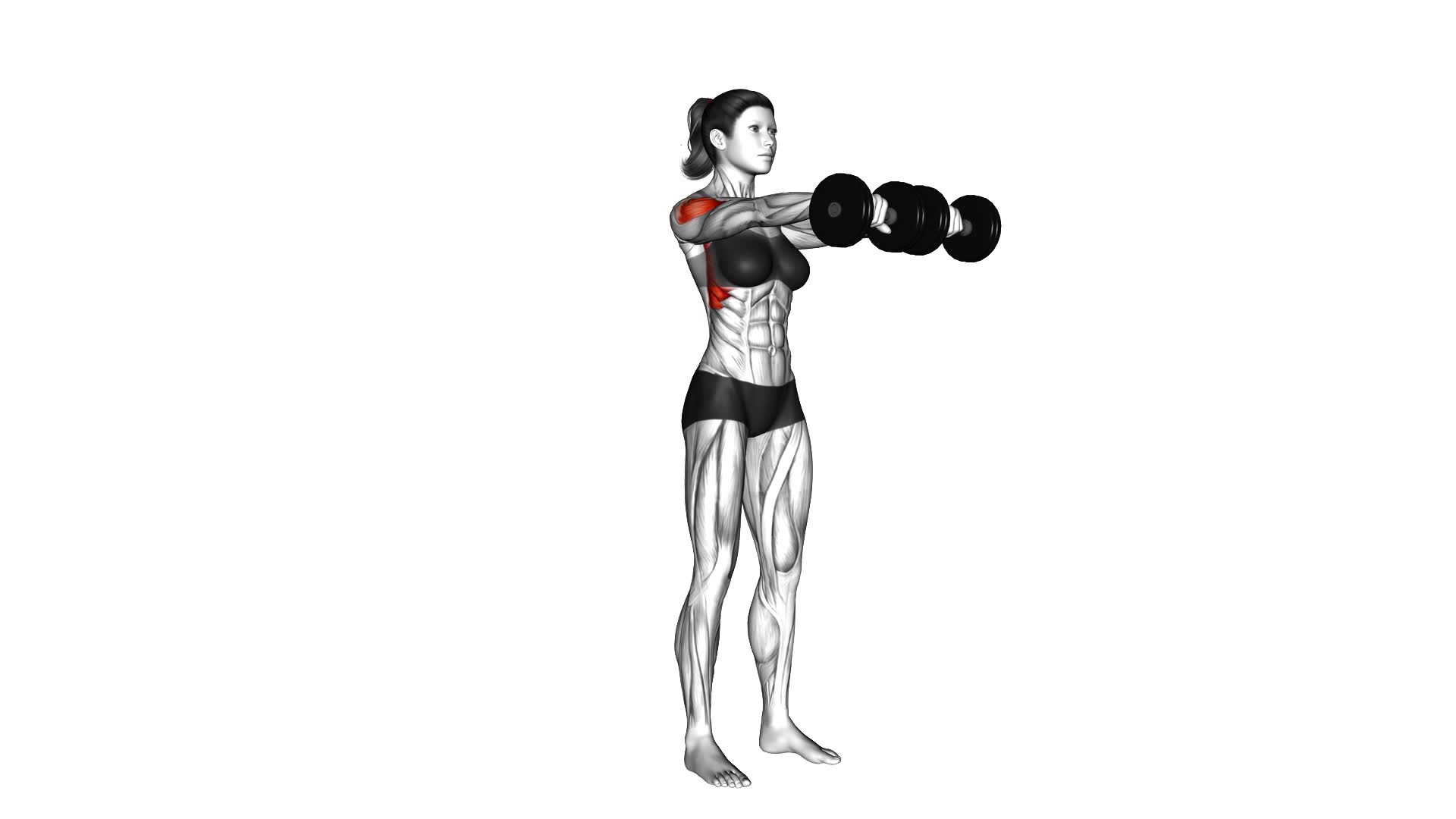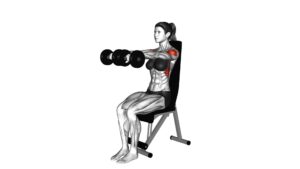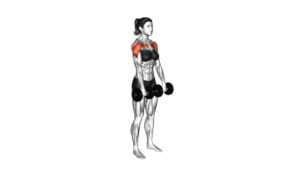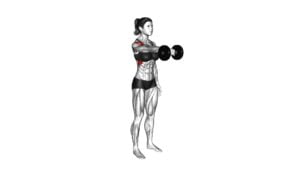Dumbbell Front Raise (female) – Video Exercise Guide & Tips

Looking to tone your shoulders and build strength? Check out this video exercise guide and tips for the dumbbell front raise specifically designed for females.
Watch This Exercise Video
In just a few minutes, you'll learn the proper form and technique, as well as variations to challenge yourself. Avoid common mistakes and get expert tips on incorporating this exercise into your workout routine.
Get ready to feel the burn and achieve your fitness goals with the dumbbell front raise!
Key Takeaways
- Dumbbell front raises target and strengthen the shoulder muscles, specifically the anterior deltoid.
- They enhance shoulder stability and improve upper body strength.
- Dumbbell front raises improve posture by pulling the shoulders back and preventing slouching.
- They enhance overall shoulder mobility for better range of motion.
Benefits of Dumbbell Front Raise for Females
To reap the benefits of the dumbbell front raise, females can effectively target and strengthen their shoulder muscles. This exercise specifically focuses on the anterior deltoid, which is the front part of the shoulder. By performing the dumbbell front raise, women can enhance shoulder stability and improve upper body strength.
One of the key benefits of the dumbbell front raise for females is improved posture. Strong shoulder muscles help to pull the shoulders back and prevent slouching, which can contribute to a more confident and upright stance. Additionally, this exercise can enhance overall shoulder mobility, allowing for better range of motion in daily activities and other exercises.
It is important to note that the dumbbell front raise can be modified to suit different fitness levels. For beginners, starting with lighter weights and gradually increasing the resistance is recommended. This helps to prevent strain or injury while still reaping the benefits of the exercise. Intermediate and advanced individuals can challenge themselves by using heavier weights or incorporating variations such as the alternating dumbbell front raise or the seated dumbbell front raise.
Proper Form and Technique for Dumbbell Front Raise
How can you perform the dumbbell front raise with proper form and technique? The dumbbell front raise is a great exercise for targeting the front deltoids, and performing it with proper form is essential to maximize its benefits and prevent injury.
To begin, stand with your feet shoulder-width apart and hold a dumbbell in each hand, palms facing down. Keep your core engaged and maintain a slight bend in your elbows throughout the movement.
Slowly lift the dumbbells forward and upward, stopping when your arms are parallel to the ground. Avoid using momentum or swinging your body to lift the weights. Focus on contracting your front deltoids and control the movement as you lower the dumbbells back to the starting position.
Common mistakes to avoid include lifting the weights too high, rounding your shoulders, or using excessive weight. Remember to start with a weight that allows you to maintain proper form and gradually increase the intensity as you progress.
As you become more comfortable with the dumbbell front raise, you can challenge yourself with variations.
Variations to Challenge Yourself With Dumbbell Front Raise
Challenge yourself with different variations of the dumbbell front raise to target your front deltoids and enhance your workout. Here are some modifications and advanced techniques to try:
- Alternating Front Raise: Instead of raising both dumbbells simultaneously, lift one dumbbell at a time while keeping the other arm extended. This variation adds an extra element of stability and control to your workout.
- Arnold Press: Start with the dumbbells in a neutral grip position, palms facing your body. As you lift the dumbbells, rotate your palms outward until they face forward at the top of the movement. This modification engages not only your front deltoids but also your side deltoids and biceps.
- Single Arm Cable Front Raise: Attach a single handle to a low cable pulley. Stand facing away from the machine and hold the handle with one hand. Keep your arm straight as you raise it in front of you. This variation provides a constant tension throughout the exercise.
By incorporating these dumbbell front raise modifications and advanced techniques into your routine, you can challenge your muscles in new ways and take your workout to the next level.
Now, let's move on to the next section to learn about common mistakes to avoid during the dumbbell front raise.
Common Mistakes to Avoid During Dumbbell Front Raise
While incorporating the modifications and advanced techniques mentioned in the previous subtopic, it's important to be aware of common mistakes to avoid during the dumbbell front raise. By understanding and avoiding these mistakes, you can maximize the effectiveness of your workout and reduce the risk of injury.
One common mistake is using too much weight. It's important to start with a weight that allows you to maintain proper form throughout the exercise. Using excessively heavy weights can lead to improper technique and strain on the muscles and joints.
Another mistake is swinging the dumbbells. This often happens when individuals try to lift heavier weights than they can handle. Swinging the weights not only reduces the effectiveness of the exercise but also increases the risk of injury. To avoid this mistake, focus on using controlled movements and keeping your body stable.
Improper posture is another mistake to watch out for. It's essential to maintain a neutral spine and engage your core throughout the exercise. Avoid arching your back or hunching your shoulders.
To transition into the subsequent section about tips for incorporating dumbbell front raise into your workout routine, it's crucial to be aware of these common mistakes and work on correcting them. By avoiding these mistakes, you can ensure that you're performing the exercise correctly and getting the most out of your workout.
Tips for Incorporating Dumbbell Front Raise Into Your Workout Routine
To maximize the effectiveness of your workout and achieve the desired results, incorporate dumbbell front raises into your routine with these helpful tips:
- Start with a suitable weight: Choose dumbbells that challenge your muscles without compromising your form. It's better to start with lighter weights and gradually increase as you build strength and confidence.
- Focus on proper form: Stand with your feet shoulder-width apart, holding a dumbbell in each hand with your palms facing down. Slowly lift the weights in front of you, keeping your arms straight but not locked. Avoid using momentum or swinging your body to lift the weights.
- Progress gradually: As you become more comfortable with the exercise, you can progress by increasing the weight or incorporating variations. For instance, you can try performing the front raise on an incline bench or alternating between arms to target different muscles.
Incorporating dumbbell front raises into your upper body workout routine can help strengthen your shoulders, upper back, and arms. Remember to always warm up before starting any exercise and listen to your body. With consistency and proper technique, you'll soon reap the benefits of this effective exercise.
Frequently Asked Questions
How Many Sets and Reps Should I Do for the Dumbbell Front Raise?
When doing the dumbbell front raise, it's important to know how many sets and reps to do. To properly perform this exercise, start by standing with your feet shoulder-width apart and holding a dumbbell in each hand.
Keep your arms straight and raise the dumbbells in front of you until they're at shoulder level.
As for the number of sets and reps, it depends on your fitness goals and current strength level. It's best to consult with a fitness professional for personalized recommendations.
Avoid common mistakes like using momentum or lifting too heavy weights.
What Is the Recommended Weight for Beginners Starting the Dumbbell Front Raise?
When starting the dumbbell front raise, beginners should focus on using a lighter weight to ensure proper form and avoid injury. The recommended weight for beginners is typically between 5 to 10 pounds, depending on your strength and fitness level.
Starting with a lighter weight allows you to gradually build strength and progress over time. Remember to always listen to your body and don't push yourself too hard, especially when starting out.
Can I Perform the Dumbbell Front Raise With a Barbell Instead of Dumbbells?
Yes, you can perform the dumbbell front raise with a barbell instead of dumbbells. Using a barbell can offer some alternatives to the dumbbell front raise exercise.
You can hold the barbell with an overhand grip and raise it in front of you, just like you'd with dumbbells. However, be aware that using a barbell might require more stability and control due to its longer length and heavier weight.
Make sure to start with a manageable weight and focus on proper form to avoid injury.
Are There Any Specific Muscles That the Dumbbell Front Raise Targets?
When performing the Dumbbell Front Raise, it targets specific muscles in your shoulders. This exercise helps to strengthen and tone your deltoids, which are the muscles responsible for raising your arms in front of you.
To maximize results, choose a weight that challenges you but allows you to maintain proper form. Aim for 8-12 reps and 2-3 sets.
While you can use a barbell instead of dumbbells, using dumbbells allows for better posture improvement and targeting of the shoulder muscles.
Can the Dumbbell Front Raise Help to Improve My Posture?
Incorporating the dumbbell front raise into your workout routine can have several benefits, including improving your posture. By targeting the muscles in your shoulders, it helps to strengthen and stabilize them, which can lead to better alignment and posture.
To perform this exercise properly for optimal results, hold a dumbbell in each hand, start with your arms at your sides, and lift them forward until they're parallel to the ground. Remember to engage your core and maintain proper form throughout the movement.
Conclusion
In conclusion, the dumbbell front raise is a beneficial exercise for females that targets the shoulders and upper body. By following proper form and technique, you can effectively strengthen and tone your muscles.
To challenge yourself, try variations such as using heavier weights or performing the exercise on an unstable surface. Avoid common mistakes like using momentum or lifting with your back.
Incorporate the dumbbell front raise into your workout routine for improved strength and overall fitness.

Author
Years ago, the spark of my life’s passion ignited in my mind the moment I stepped into the local gym for the first time. The inaugural bead of perspiration, the initial endeavor, the very first surge of endorphins, and a sense of pride that washed over me post-workout marked the beginning of my deep-seated interest in strength sports, fitness, and sports nutrition. This very curiosity blossomed rapidly into a profound fascination, propelling me to earn a Master’s degree in Physical Education from the Academy of Physical Education in Krakow, followed by a Sports Manager diploma from the Jagiellonian University. My journey of growth led me to gain more specialized qualifications, such as being a certified personal trainer with a focus on sports dietetics, a lifeguard, and an instructor for wellness and corrective gymnastics. Theoretical knowledge paired seamlessly with practical experience, reinforcing my belief that the transformation of individuals under my guidance was also a reflection of my personal growth. This belief holds true even today. Each day, I strive to push the boundaries and explore new realms. These realms gently elevate me to greater heights. The unique combination of passion for my field and the continuous quest for growth fuels my drive to break new ground.



